Osteoarthritis of the knee: the progressive and on the other hand, degenerative pathology is. First, it affects the cartilage, the tissue and, then, in the destructive process involved the bone structure.
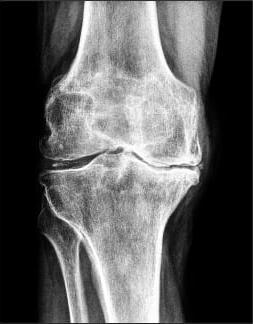
Causes of the development of osteoarthritis are high physical loads of low motor activity, metabolic and endocrine disorders. Leaders of the clinical manifestations of the pathology is the pain is worse when walking and functional insufficiency of the knee and its deformation. With the progression of osteoarthritis develops ankylosis (total or partial immobilization of the joint). During the placement of diagnostic orthopedic focuses on the results of research instruments for arthroscopy, x-ray, computed tomography, magnetic resonance imaging. In the treatment of osteoarthritis of 1 and 2 degree of severity are used in pharmacological preparations, physiotherapy carry out physical therapy and massage. The ineffectiveness of conservative therapy or in the detection of the pathology is in the final phase of the patient and to prepare for the knee replacement.
Characteristics of the disease
Osteoarthritis of the knee (gonarthrosis) — one of the most frequently diagnosed pathologies that affect this joint. Under the influence of internal or external negative factors in the cartilage tissue causes a deficit of nutrients. In consequence, it breaks the food chain, slows the regeneration of connective tissue structures. It causes premature aging of the hyaline cartilage. It drops, cracks, becomes rough, loses strength, elasticity and elasticity. The cartilage, the tissue that they can no longer fulfill its primary function, the reduction of the friction at the points of union of the bones. Subchondral bone is opened, the tree, condense, they produce osteosclerotic changes. For the stabilization of the knee joint during gait grow, flattened bone edges of the disks with the formation of osteophytes (bone spurs).
Osteophytes in the knee joint.
The major osteoarthritis) involving the initially healthy hyaline cartilage as a natural consequence of the reduction of its functionality and resistance. Secondary pathology is occurs in defects of the cartilage tissues. Can be triggered by lesions of the joints of the knee, inflammatory process, aesthetics, necrosis, hormonal changes, disorders of the metabolism.
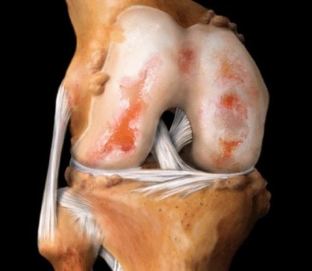
| Clinical-radiological stage of osteoarthritis of knee | Specific of the signs |
| The first | The mobility of the knee slightly decreases, the contours of the joint of the slit become blurred, some are getting closer. At the edges of the bones of the disks we observe the formation of a small amount of osteophytes |
| The second | Flexion or right knee extension will hear a crackling, clicks, pops. The muscles are moderately stunted, it narrows noticeably joint of the slit, it generates a considerable amount of osteophytes, on bone tissue is detected subchondral osteosclerosis |
| The third | The knee joint is deformed, sharply limits their mobility. It is observed, partial or total fusion of the joint of the slit, a great number of bone tumors, subchondral cysts pathologic entities, move freely in the joint cavity |
Causes and triggers of the
Impetus to the development of destructive-degenerative process in hyaline cartilage that normally turns on several negative factors. The cause of the development of osteoarthritis of the knee in childhood and adolescence are disorders of the formation of system ligament-tendon unit, the dysplasia. This, in turn, due to hereditary predisposition. Lead to destruction of the cartilage can be different injuries: fractures, heavy bruising, sprains, partial or complete tears of ligaments, muscles, tendons, menisci. An excessive load on the joint cause the development of pathology is. The disorder post-traumatic osteoarthritis develops over several (3 to 5 years after the damage connective tissue or of the bone structure. The pathology is may occur after surgical intervention. And the cause is not the incompetence of doctors, and a considerable amount of damage in the cartilage and the acceleration of the regeneration. The onset of diseases that predispose to the following factors:
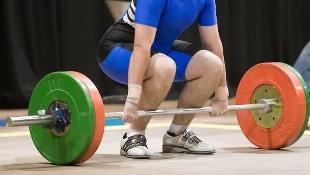
- the excess of body weight, in which virtually all the structures of the locomotor system, and especially in the knees, suffering from an excess of training.
- the excessive physical activity, often causes the microtraining the cartilage of the tissues and favoring the progression of the destructive processes;
- the sedentary lifestyle, which worsens the blood supply to the legs and a deficit of nutrients in hyaline cartilage;
- the system inflammatory and atrophic pathology is — rheumatoid, psoriatic arthritis, gout, treating osteoporosis, systemic lupus erythematosus.
The clinical picture
In the majority of cases of osteoarthritis of the knee, manifested that it hurts, dull pain after physical activity. A cause becomes irritating effect of osteophytes located close to the soft tissues, venous stasis, guided intra-articular hypertension, muscle spasm. For osteoarthritis is characterized by the "launch pad" the pain that appears due to the swelling of the joint, or synovitis reactive. When a person spends a lot of time in the sitting position, and then rises up, then the first steps if you feel a bit of pain. The rise of the so-called "blocking" of pain on a regular basis. The joints of the knee during gait "shim" as a result of the crushing of the damaged part of the cartilage, the tissue between the two surfaces of the joint. Also in osteoarthritis is characterized by the following symptoms:
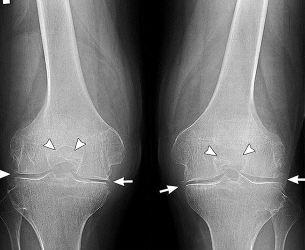
- crepitus, or the crackling of the flexion or right knee extension, arises when the displacement of bone structure with respect to the other at the bottom of the Antoniushof of cartilage;
- the stiffness, the expressiveness of which grows as the adhesions from the joint of the slit;
- the spasms of the muscles located in the area of the knee, generally appear to reduce the pain;
- the deformation of the joint, active, destructive changes in subchondral bone.
Osteoarthritis person is difficult to climb stairs and take long walks by the constant pain of the knee. During the pathology is very often for synovitis — inflammation of the synovial lining of shells. Clinically manifest training rounded elastic sealing, hyperemia, strong swelling, increased body temperature up to 37.1—38 °C. in the absence of medical intervention of osteoarthritis is complicated spontaneous a hemarthrosis (bleeding into the joint cavity of the knee), partial or total loss of mobility, the osteonecrosis of the femoral condyle, external subluxation of the patella.
The diagnosis
The clinical picture of arthrosis, especially complicated synovitis, quite similar to that of the sintomatologa of many inflammatory diseases of the locomotor apparatus. Therefore, we performed a differential diagnosis to exclude from the arthritis, the tendinitis of carpal tunnel syndrome. With the help of research instruments to determine the state of the knee joint and the degree of their functional activity. In the diagnosis of osteoarthritis is more informative of the x-ray. The images are well visible, have been formed osteophytes, reduced joint of the slit, the deformation of the bone structure (cysts, subchondral osteosclerosis). Symmetry in the narrowing of the joint cleft of the knee joint affected by osteoarthritis). Probably, submitted to the operation will have to both limbs. With more detail to evaluate the changes in the hyaline cartilage that allow the ultrasound, the mri, the ct scan. The research will also be conducted to identify inflammatory or degenerate the defeat of the soft tissues, muscles, ligaments and tendons. If it is necessary, is performed the arthroscopy — a minimally invasive surgical manipulation. In the process of diagnostic procedure studied the interior of the joint, makes the extraction of biomaterials — synovial shells, the joint fluid, the cartilage tissue. When the synovitis by the puncture is extracted from the exudate, both to improve the well-being of the patient, as for the study of its composition.
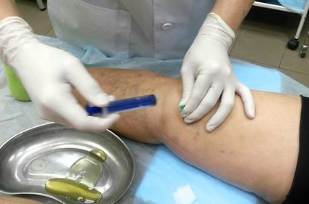
The tactic of treatment
Osteoarthritis of the knee-1 degree of gravity rather responds well to treatment with the physiotherapist and prolonged chondroprotectors. Normally, it is not necessary to the use of analgesics, as well as the symptoms expressed is not bright or not. Osteoarthritis of the knee grade 2 also performed a conservative treatment. But if the disease progresses or have been diagnosed with the destruction of a large amount of the cartilage tissue, shall be submitted to a surgical operation, usually of the arthroplasty. In some cases, the patients is shown arthrodesis artificial analogous to ankylosis, or complete immobilization of the knee.
Non-drug therapy
Sick of osteoarthritis) 2 or 3 degrees, from the first days of treatment is recommended the use of units of hard or semi-hard orthotic, significantly restrict the mobility of the knee. With a small damage on the cartilage, simply paris with the use of soft elasticated roller — pads. Are set at right angles, warn of further destruction of the tissues. Patients should reduce physical activity, no heavy lifting, avoid the long walk. Assigned physical therapy procedures (from 5 to 10 sessions), to improve the circulation of blood in the knee, and the stimulation of the regeneration of the connective tissue structures:
- magnet;
- lazeroterapiya;
- electrotherapy high frequency;
- electrophoresis with anesthetics and protectors of cartilage;
- with applique ozokerite and (or) diesel.
Strengthen the musculo-ligamentous team and improve the motor functions of the knee will help only the more important regular classes of physical culture medicinal. The doctor physical therapy sets out the exercises individually for each patient depending on the degree of osteoarthritis and physical preparation. The first training will be held under your control. Osteoarthritis is expressly prohibited any type of intense movement. Improve the circulation of the blood, but at the same time is going to cause even more mikrotemperaturnye the cartilage. The movements should be smooth, measured, with a small amplitude. In an early stage of knee osteoarthritis arise destructive changes in the cartilage can be resolved with the help only of the physical culture medical. Well it has been consolidated hirudotherapy, or medical treatment with leeches. In the absence of indications in the joint to put 3-4 leeches, usually in the area of the kneecap. Surrounded by worms bite the skin and inject in the blood, the saliva with a huge amount of biologically active substances.
Pharmacological remedies
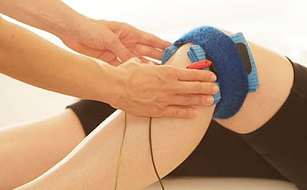
For the solution of severe pain in the knee are performed after blockade with corticosteroids. Hormonal means are often combined with anesthetics. Guided Intra-articular injection in osteoarthritis is executed only when the need as well as for corticosteroids characterized expressed side of the manifestation. More often in the treatment of osteoarthritis is applied nonsteroidal anti-inflammatory drugs in different pharmaceutical forms:
- the solutions for parenteral injection;
- pills;
- ointments and gels.
In therapeutic schemes necessarily include chondroprotectors in the form of injections or pills. These tools stimulate the regeneration of the wear and tear of the cartilage, have an anti-inflammatory, analgesic and anti-edema action. Any knee pain should be a signal for the immediate treatment of the orthopaedic. A timely manner made the treatment of osteoarthritis will grow to avoid the development of serious complications, in some cases, will be advised of the disability of the patient.

















































